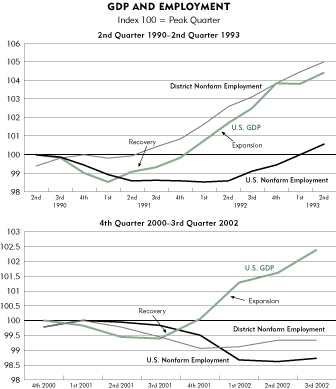A "jobless expansion" describes the current stage of the U.S. business cycle. While the total output of goods and services in the economy has grown beyond its peak prior to the last recession, nonfarm employment is at levels below its pre-recession peak.
Although the National Bureau of Economic Research hasn't set the date for the end of the most recent recession, real GDP surpassed its fourth quarter 2000 peak of $9,244 billion by fourth quarter 2001. It took three quarters for output to drop to its low point in third quarter 2001, and one quarter of growth to surpass the pre-recession peak. Real GDP has made gains every quarter since.
However, job growth has not followed the relatively fast recovery in real GDP. In first quarter 2001 nonfarm employment reached a peak at 132.4 million jobs. Employment then dropped for five consecutive quarters and has grown modestly for one quarter. However, by third quarter 2002, nonfarm employment, with 130.9 million jobs, is still below its pre-recession peak.

Source: Federal Reserve Bank of Minneapolis
In eight previous recessions since World War II, nonfarm employment has taken on average 2.4 quarters longer than GDP to move through the peak-recession-recovery cycle. Therefore a jobless expansion of some duration is to be expected following a recession.
As of third quarter 2002, nonfarm employment in the district and the United States had been below its pre-recession peak for six quarters, two longer than GDP. However, while recent employment gains have been soft, productivity has increased, and companies have been able to increase profit margins. This may bode well for employers to expand hiring in the future. After all, the largest expansion in both output and jobs in peacetime history followed the 1990-91 recession, when it took five quarters longer for job growth than GDP to surpass its pre-recession peak.





